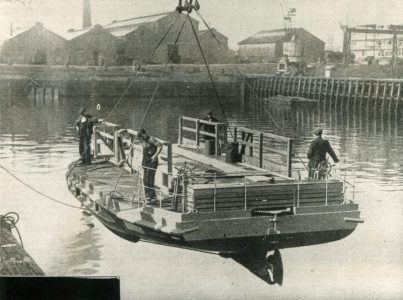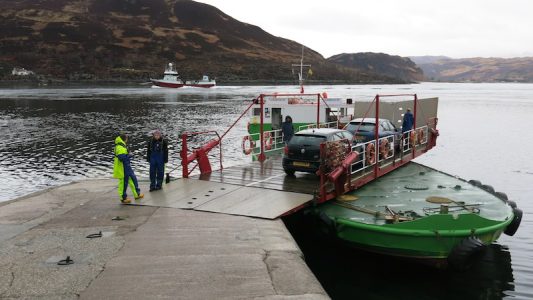Robert Beale tells the story of Scotland’s sole surviving turntable ferry.
Quietly crossing the narrows at Glenelg, year after year since 1983, is Glenachulish. This small vessel is the last in a line of turntable ferries that were unique to Scottish waters and, with one exception, operated exclusively on the western seaboard. She is the culmination of more than a century of evolution since the tiny Glencoe, launched in 1912 for the service across Loch Leven at Ballachulish.
Turntable ferries were developed in the early 20th century as motor vehicle ownership increased. Many roads on the Scottish west coast circumnavigated large sea lochs. Often a short ferry could save an awfully long detour, Strome Ferry being a prime example, and as such these ferries were often seen as part of the road network. The design had to evolve as road vehicles did, but despite rapid advances in the design of ferries for the open seas, the mechanism underlying turntable ferries, running across narrow straits, has remained the same: a turntable mechanism, occupying most of the surface area of the ferry, allows cars to be loaded and unloaded swiftly at slipways at all states of the tide, without obliging drivers to reverse. Cars are driven on, the turntable is manually moved through 180 degrees, and the ferry sets off across the narrows to the other side, where cars can be driven straight off.
The principle is both simple and ingenious, but the success of the design was eventually its downfall. Crossings became so busy that the little ferries were unable to cope with demand. Even with three or sometimes four vessels running simultaneously at Ballachulish, queues still built up. The largest turntable ferries, at Corran and Strome, were capable of carrying up to nine cars, but still demand was too high. Eventually bridges, new roads or end-loading ferries replaced the majority of turntable ferries.
Glenachulish, the subject of our photo of the month, was launched in 1969 from the yard of the Ailsa Shipbuilding and Engineering Company of Troon, where she was built by apprentices. Commissioned for the short crossing at Ballachulish, she operated there until the bridge opened in 1975, and then saw service elsewhere under the control of Highland Regional Council — at Corran on Loch Linnhe, Kylesku in Sutherland and then Kessock across the Beauly Firth at Inverness. When the Kessock Bridge opened in 1982, Glenachulish became surplus to requirements and was placed on the ‘for sale’ list. Murdo Mackenzie, operator of the ferry across the Glenelg Narrows, purchased her and she joined her ex-fleetmate Glen Mallie at Kylerhea.

Balancing act: the tiny Glencoe at Ballachulish a century ago — copyright photo CRSC J.T.A. Brown Collection
The vehicle crossing there had started in 1935 with the introduction of Kylerhea, a primitive little ferry which provided an on/off service until 1951, with an absence during the Second World War. Her replacement was Kyleakin (1), which had been the first turntable ferry to operate on the busier and better known crossing between Kyle of Lochalsh and Kyleakin. Lengthened in the 1930s, Kyleakin had a capacity of just two cars (Glenachulish can carry six average sized cars). She served at Glenelg for only three years (1952-55), and was lost in a storm at Broadford in 1959.
That was the year that Murdo Mackenzie stepped in to reinstate the Glenelg-Kylerhea link on a seasonal basis. He found the partially wrecked Kylerhea and restored her, and she sailed in 1959 and 1960. A succession of former Ballachulish turntable ferries then followed: Queen of Glen Albyn (1960-61), Appin Chief (1961-1971), Glen Mallie (1969-1982) and finally Glenachulish, from 1983. Between 1969 and 1971 a two-boat service was provided — coinciding with the huge tailbacks at Kyleakin prior to the introduction of two large end-loading vessels there in the early 1970s.
These two large vessels took most of the Skye traffic, and a downturn in trade was noticed at Glenelg. During the 1980s and 1990s winter charter work, usually at Scalpay but also at Kyleakin, topped up the summer income and helped pay for maintenance. Sunday sailings were also introduced in 1993 in an effort to boost revenue.
Murdo Mackenzie retired in the late 1980s and Glenachulish was put up for sale along with the business. No ferry operated at Glenelg in 1990, but in that year one Roddy Macleod bought the business and Glenachulish re-entered service the next year.

Launched by crane on 10 August 1936, Moil was the last wooden-hulled ferry to be built for the Skye crossing at Kyleakin — copyright photo CRSC Fraser MacHaffie Collection
Roddy ran the ferry through hard times, especially when the Skye Bridge opened in 1995, and even more so when bridge tolls were abolished in 2004. He hoped to retire from the business but wanted to make sure the ferry was in good hands, and so he offered Glenelg residents the chance to own and operate their own vessel, an opportunity that was voted down locally. Luckily, the Isle of Skye Community Interest Company was set up in 2006 to own and manage Glenachulish and the ferry to Kylerhea. After initially leasing the vessel from Roddy, they raised sufficient funds to purchase her outright and, in the hands of the Community Interest Company, Glenachulish has had a successful decade. Recently she was returned to her Ballachulish colours, if a tad bright! In 2018 she will be added to the National Historic Ships Register.
Glenachulish is a story of survival across nearly five decades. Even when the building of bridges at Ballachulish, Kessock and Kylesku made her redundant, and despite the retirement of successive owners, she always found a useful new role. Still she sails each summer on the crossing to Skye, and long may she continue to do so.
Robert Beale is CRSC vice-president and co-author with John Hendy of Scotland’s Turntable Ferries (Lily Publications £16).
Glenachulish operates from Easter to October, seven days a week between 10am and 6pm (7pm in June, July, August). The single fare for a car and up to four passengers is £15.

Glenachulish prepares to cross Waverley’s wake as the paddler steams south through the Glenelg Narrows on 3 June 2016 — copyright photo CRSC/Andrew Clark
Published on 8 August 2016















